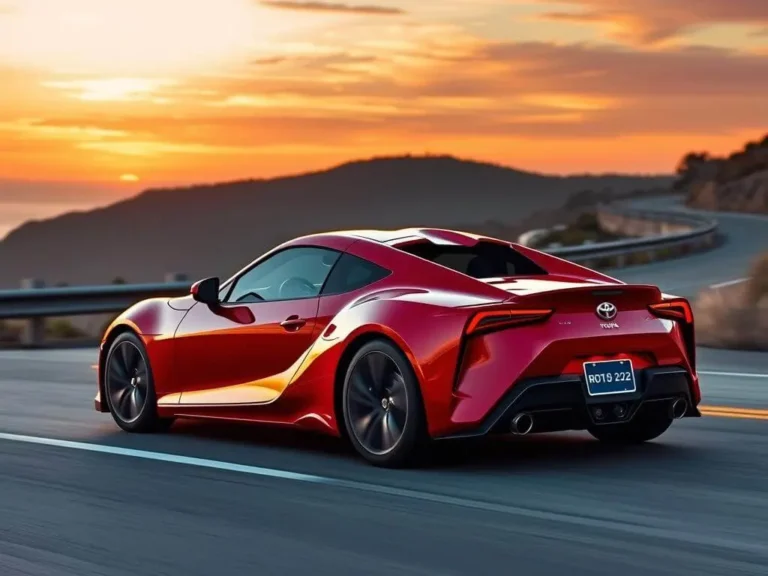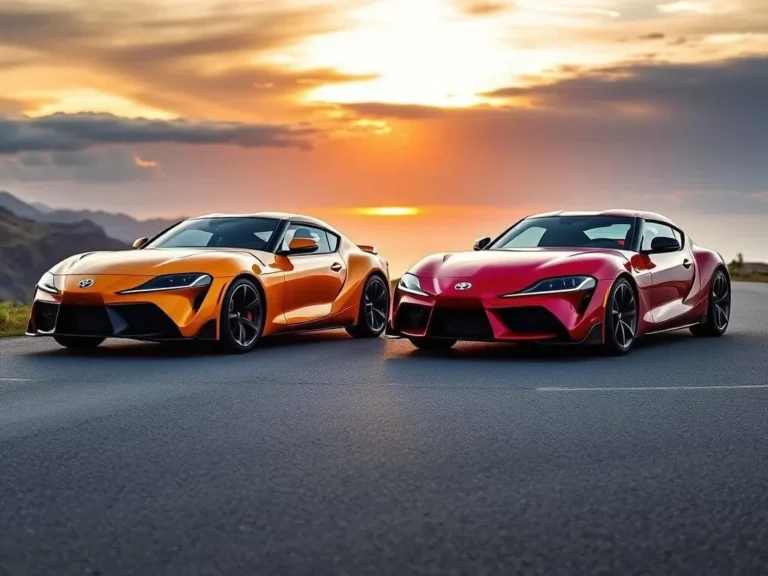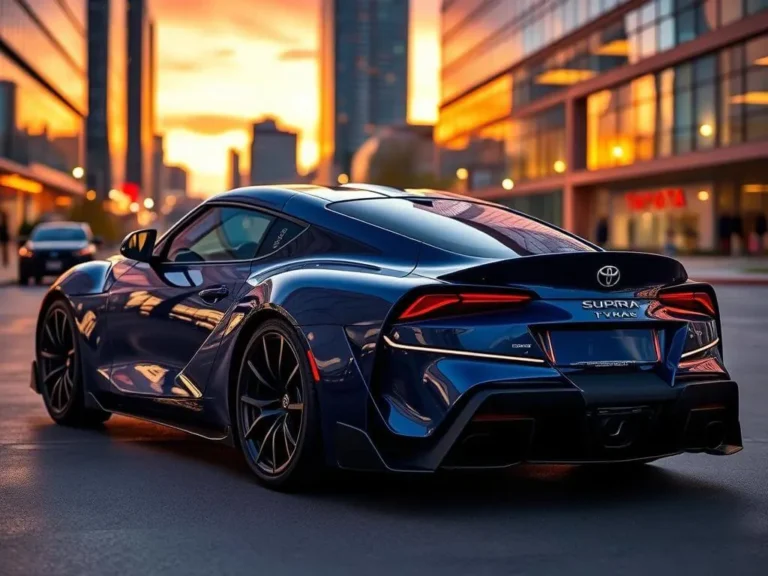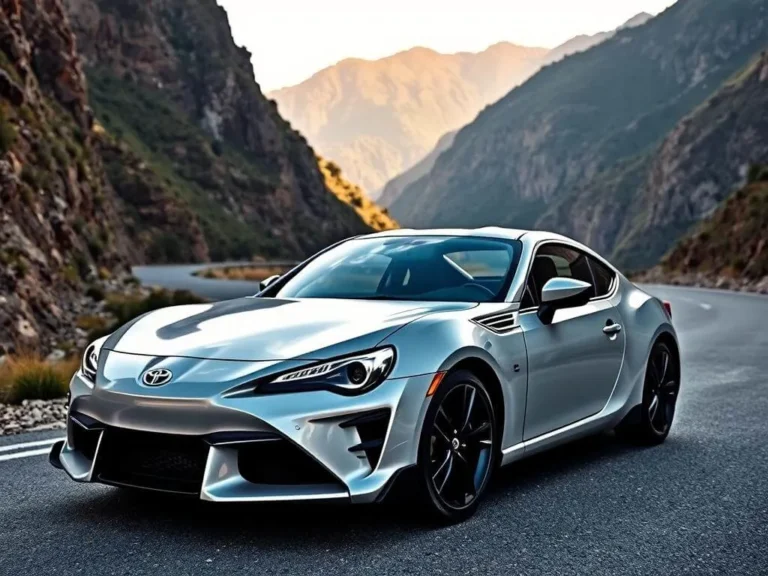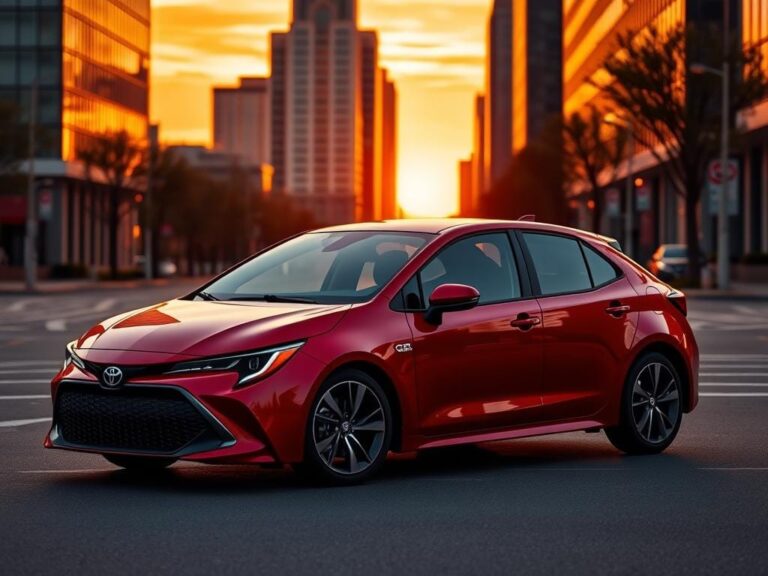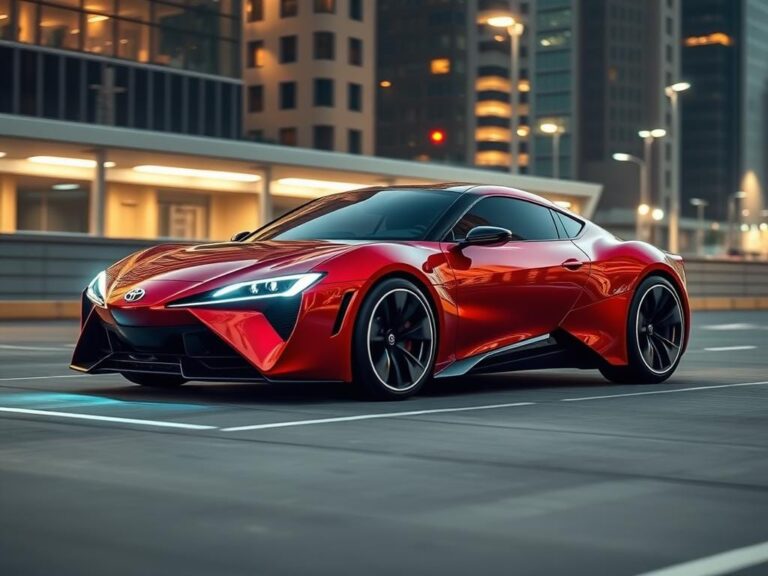1992 Toyota Supra: A Sports Car Icon
Ever wondered why the 1992 Toyota Supra is so legendary? It’s because of its rich history, eye-catching design, and amazing performance. These qualities made it a true icon among Japanese sports cars. Let’s look at how it evolved from a Celica derivative to a standalone model that changed the car world.
The 1992 Toyota Supra marked a big change. It was the first Supra to stand alone, not tied to the Celica. It kept its rear-wheel drive, unlike the Celica’s switch to front-wheel drive. This year’s Supra had a 3.0-liter engine that made 200 hp and 196 lb-ft of torque. The turbo version was even more powerful, with 230 hp and 246 lb-ft of torque.
Table of Contents
Toyota Supra Legacy
The Toyota Supra started in 1978 as a version of the Toyota Celica. It was made to offer more power and comfort. But, the 1986 model year was a big change. The Supra then became its own model, not just a Celica version.
Evolution from Celica to Independent Model
In 1986, the Supra changed from a Celica to its own sports car. This new Supra Mark III had a fresh chassis and body. It looked sleek and simple, fitting the style of the time.
The Birth of a Japanese Sports Car Legend
The Toyota Supra’s story kept growing, becoming a symbol of Japanese sports cars. Starting as a Celica and becoming its own model, the Supra won hearts. It’s now seen as a legend in the car world.
The History Behind the 1992 Toyota Supra
The 1992 Toyota Supra was part of the third-generation (Mark III) model that started in 1986. This generation brought big upgrades, like the turbocharged option in 1987, which increased power to 230 horsepower. The Mark III Supra was made for six years, with a total of 108,565 units produced.
In 1986, Toyota made 33,283 Supra MK3 units. The 1987 Toyota Supra MK3 Turbo model had 29,907 units. The turbocharged models had different power and torque, with the 1987 model having 230 horsepower and 246 lb-ft of torque.
The weight of the Supra MK3 varied, affecting its performance and handling. The heavier turbocharged models needed extra parts. The engine options, performance, interior, exterior, and tech were all tailored for different markets.
| Model Year | Total Units Produced | Horsepower | Torque (lb-ft) |
|---|---|---|---|
| 1986 Toyota Supra MK3 | 33,283 | 200 | 232 |
| 1987 Toyota Supra MK3 Turbo | 29,907 | 230 | 246 |
The 1992 Toyota Supra was a step towards the legendary Mark IV Supra. It became a symbol in the import sports car tuning world. Its unique style, advanced tech, and strong performance set the stage for the mk4 supra’s fame.
Design and Exterior Features
The 1992 Toyota Supra was known for its sleek design. It had pop-up headlights that made it look sporty. Toyota also offered a Targa top for open-air driving, adding to its athletic look.
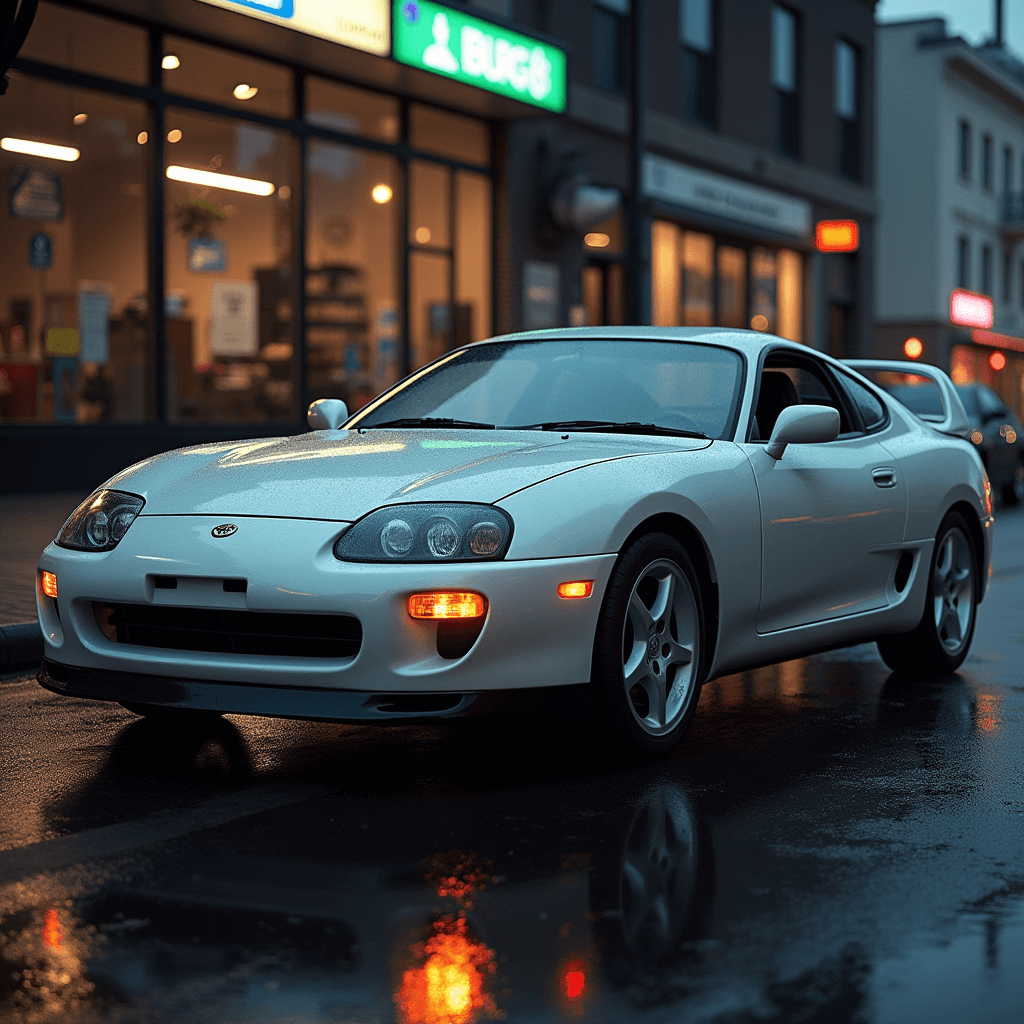

Aerodynamic Styling Elements
The Supra’s body was made to improve performance. It had a Seibon® Carbon Fiber Hood and a Carbon Creations® Carbon Fiber Rear Lip Spoiler. These features cut down on drag and made it stable at high speeds.
Iconic Pop-up Headlights
The 1992 Toyota Supra was easy to spot with its pop-up headlights. These headlights made the Supra look even better. They also helped with airflow, making driving more enjoyable.
Targa Top Option
The Supra had a Targa top for those who loved driving with the wind. This removable roof kept the car safe while letting drivers feel the road. It made driving an exciting experience.
The 1992 Toyota Supra was a perfect mix of design and function. Its aerodynamic look, iconic features, and customization options made it a standout sports car.
Performance Specifications of the 1992 Toyota Supra
The 1992 Toyota Supra was a powerhouse, thanks to its twin-turbo inline-6 engine. The turbo version could hit speeds of about 155 mph. It was a real sports car legend.
The naturally aspirated 3.0-liter engine had 200 horsepower and 196 lb-ft of torque. The turbocharged 2.5-liter 2JZ-GTE engine, however, had 276 horsepower and 268 lb-ft of torque.
These engines came with either a five-speed manual or a four-speed automatic. This gave drivers a mix of performance and ease of use. The Supra’s balanced chassis and suspension made it a joy to drive.
| Engine | Displacement | Horsepower | Torque | Top Speed |
|---|---|---|---|---|
| 2.5L 1JZ-GTE Twin-Turbo I6 | 2.5 liters | 276 hp | 268 lb-ft | 155 mph |
| 3.0L 7M-GTE Single-Turbo I6 | 3.0 liters | 232 hp | 253 lb-ft | 143 mph |
The 1992 Toyota Supra was a legendary sports car. Its performance, design, and tech made it unforgettable. Today, it’s a highly sought-after model among car lovers.
Engine Options and Power Output
The 1992 Toyota Supra came with two powerful engine options. These engines were the result of top-notch Japanese sports car engineering. You could choose between a 2.5L 1JZ-GTE twin-turbo inline-6 or a 3.0L 7M-GTE single-turbo inline-6 engine.

2.5L 1JZ-GTE Twin-Turbo Configuration
The 2.5L 1JZ-GTE twin-turbo inline-6 engine was the highlight of the 1992 Supra. It produced 276 horsepower at 6,200 rpm and 268 lb-ft of torque at 4,800 rpm. With a compression ratio of 8.5:1 and advanced electronic fuel injection, it offered exceptional performance and quick response.
3.0L 7M-GTE Single-Turbo Variant
The 3.0L 7M-GTE single-turbo inline-6 engine was for those who wanted balanced power. It made 232 horsepower at 5,600 rpm and 253 lb-ft of torque at 3,200 rpm. It had a compression ratio of 8.4:1 and electronic fuel injection.
| Engine | Displacement | Horsepower | Torque | Compression Ratio |
|---|---|---|---|---|
| 1JZ-GTE Twin-Turbo | 2.5L | 276 hp @ 6,200 rpm | 268 lb-ft @ 4,800 rpm | 8.5:1 |
| 7M-GTE Single-Turbo | 3.0L | 232 hp @ 5,600 rpm | 253 lb-ft @ 3,200 rpm | 8.4:1 |
Transmission and Drivetrain Features
The 1992 Toyota Supra came with two transmission options. Drivers could choose the five-speed manual for its power handling. This was perfect for the turbocharged models.
For a smoother ride, the 1992 Toyota Supra had a four-speed automatic. Both options kept the rear-wheel drive, enhancing the car’s handling and performance.
| Transmission | Gears | Power Handling |
|---|---|---|
| Manual | 5-speed | Designed for turbocharged models |
| Automatic | 4-speed | Suitable for daily driving |
The 1992 Toyota Supra had rear-wheel drive. This made it stand out with its handling and performance. It offered balanced weight and precise cornering, pleasing drivers.
Interior Comfort and Technology
The 1992 Toyota Supra’s interior was made for the driver. It had clear analog gauges for quick info. The 2+2 seating was sporty yet practical, with leather or cloth options.
The Supra had many premium features. These included a power-adjustable driver’s seat and a leather-wrapped steering wheel. It also had automatic climate control and an AM/FM cassette player.
| Feature | 1992 Toyota Supra |
|---|---|
| Seating Configuration | 2+2 |
| Upholstery Options | Leather or Cloth |
| Power-Adjustable Driver’s Seat | Yes |
| Leather-Wrapped Steering Wheel | Yes |
| Automatic Climate Control | Yes |
| Audio System | AM/FM Cassette |
| Cruise Control | Available |
| Power Windows | One-Touch |
The 1992 Toyota Supra’s interior was top-notch for its time. It offered a driver-focused experience with premium features. Yet, it missed some modern tech. Still, its design made it a favorite among sports coupe fans.
Toyota Electronic Modulated Suspension (TEMS)
The 1992 Toyota Supra, part of the JZA80 series, brought advanced tech with the Toyota Electronic Modulated Suspension (TEMS) system. This feature was standard on turbocharged Supras and optional on naturally aspirated ones. It let drivers adjust the car’s ride to their liking and the road conditions.
TEMS had “normal” and “sport” settings for the shock absorbers. This allowed Supra fans to change how the car handled and felt. In “normal” mode, it was smoother. In “sport” mode, it was tighter and more agile, boosting the Supra’s legendary performance.
Toyota’s use of TEMS showed their dedication to engineering and the Supra’s tech-savvy sports car status. This system, along with the Supra’s powerful engines, iconic looks, and driver-focused design, made the toyota supra mk3 a symbol of the 1990s sports car scene.
The 1992 toyota supra gt with TEMS gave drivers a unique level of control and customization. This advanced suspension was key to the jza80‘s lasting fame as a beloved and capable sports car.
The Cultural Impact and Popularity
The Toyota Supra, especially the 1992 model, has made a big impact. It’s not just about its speed. It’s a favorite among car lovers and those who enjoy car tuning.
Influence on Car Tuning Culture
The Supra’s strong engines and easy to modify design make it a top pick for car fans. The tuner car scene loves the Supra. Owners customize their cars to show off their style.
They do everything from engine swaps to body kits. The Supra lets people express themselves through car tuning.
Media Appearances and Recognition
The Supra has also made a splash in movies and video games. It’s famous for its role in “The Fast and the Furious” movies. This has made it a legend in the car world.
It’s also in games like Gran Turismo and Need for Speed. This has made it even more popular among gamers and car fans.
The Toyota Supra’s fame as a tuner car and its media appearances have made it very popular. As a classic Japanese sports car, it has won the hearts of many around the world.
Market Value and Collectibility
In 2024, the 1992 Toyota Supra, especially the turbo models, is very popular among car lovers. Cars in great shape can sell for $35,000 to $50,000 at auctions. Sometimes, cars with very low mileage or in perfect condition can go over $60,000.
The value of these cars depends on their condition, how many miles they have, and if they’ve been modified. This shows how the 1992 Toyota Supra is a true classic in the car world.
The Hagerty Price Guide says the average value of a 1992 Toyota Supra is around $XX,XXX in 2024. This makes it one of the most valuable sports cars, even more than other famous Japanese cars. But, it’s not as expensive as some legendary cars like the Toyota 2000GT or the Nissan Skyline 2000 GT-R Hakosuka.
| Model | Average Market Value (2024) |
|---|---|
| 1992 Toyota Supra | $XX,XXX |
| Toyota Corolla GT AE86 (1983-1988) | $21,615 |
| Toyota Land Cruiser J40 (1961-1985) | $37,482 |
| Mazda Cosmo (1967-1996) | $76,575 |
| Honda Civic (1972-1979) | $11,516 |
| Datsun 240Z (1970-1973) | $34,811 |
| Toyota 2000GT (1967-1970) | $1.1 million |
| Nissan Skyline 2000 GT-R Hakosuka (1968-1972) | $122,028 |
The value of the 1992 Toyota Supra, especially the turbo models, keeps going up. This shows how much people love and want to keep these cars. The 1992 Toyota Supra is likely to stay a valuable and sought-after car for collectors.
Comparison with Contemporary Sports Cars
The 1992 Toyota Supra was a standout among sports cars of its time. It showed off its turbocharged power, making Toyota a major player in the high-performance world. It competed with big names from Europe and America, proving Toyota’s worth.
Performance Benchmarks
The 1992 Toyota Supra was a powerhouse, thanks to its turbocharged engines. It could go from 0 to 60 mph in just 5.1 seconds. It reached a top speed of 156 mph, making it a top choice for speed lovers.
Market Position
In the early 1990s, the 1992 Toyota Supra found its own special place in the sports car market. It was known for its power, handling, and reliability. This made it a favorite among those who wanted a car that could do it all.
Maintenance and Ownership Considerations
Buying a 1992 Toyota Supra, especially the turbo models, needs careful upkeep. These cars were often driven hard, leading to wear and tear. This makes finding well-kept models hard to find.
But, the strong fan base and many aftermarket parts make upkeep easier. With the right care, owners can enjoy this legendary car. It’s known for its speed and growing value.
| Repair Item | Estimated Cost Range |
|---|---|
| Mass Airflow Sensor Replacement | $630 – $929 |
| Oil Pressure Sensor Replacement | $220 – $262 |
| Engine Coolant Temperature Sensor Replacement | $429 – $496 |
| Timing Chain Tensioner Replacement | $369 – $410 |
| Hood Latch Replacement | $193 – $207 |
The upkeep for a 1992 Toyota Supra costs about $495 a year. Fuel costs for a Toyota Supra MK4 are around $3,650 annually. Remember, the value of a 1992 Toyota Supra MK3 can drop by up to 25% in five years.
Despite upkeep needs, the 1992 Toyota Supra is very durable. Some have gone over 500,000 miles. The value of a 1993 Toyota Supra MK4 can reach over $260,000 in top condition.
Knowing about maintenance and ownership of the 1992 Toyota Supra helps fans make smart choices. This ensures a fun and rewarding time with this legendary car.
Conclusion
The 1992 Toyota Supra is a true icon in the world of Japanese sports cars. Its design, powerful engine, and advanced features made it a standout. It started as a Celica derivative but became a model in its own right.
The third-generation Supra set the stage for the legendary 1992 model. This car’s popularity among fans and its growing value in the collector market show its importance. The Supra Turbo model, with its 320 horsepower engine, offered an exciting drive.
The limited production of the 1997 Toyota Supra MK4 makes it even more valuable. Prices for these models range from $30,000 to $60,000. The Supra’s impact goes beyond its performance and design.
It has left a lasting cultural mark. Its appearances in media and influence on car tuning culture have made it a legend. As fans continue to seek out these cars, the 1992 Toyota Supra’s legacy will live on for many years.
Did You Like This Article?
Celica come back
Very informative and useful, details.
Good article
A lot information, thanks
Top top toyota
Celica 2025 is a top model of Toyota,
New Celica
I drove an ’81 from ’85 til ’99 and loved it. Then I got my first Nissan 240 SX. Twenty five years later, I’m on my fourth 240. Any chance of a 240SX comeback?
Toyota riders . Com
Very informative

